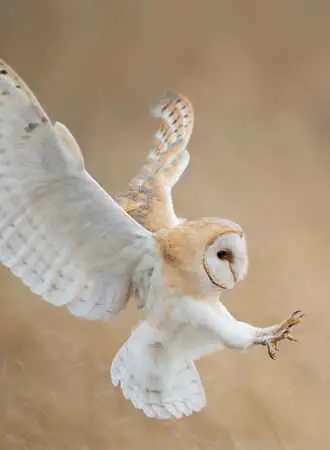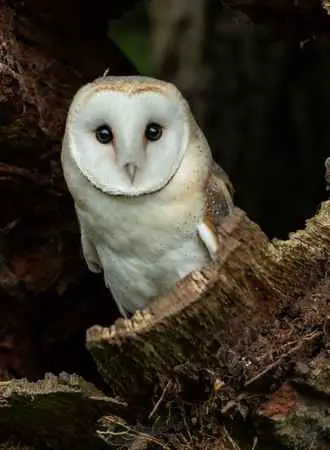While owls are more commonly known for hunting small rodents and birds, there is anecdotal evidence that they may also target indoor cats and small dogs.
In most cases, owls will avoid contact with humans and their pets. If an owl is feeling hungry or threatened, it may decide to attack. Large owl species, in particular, have been known to carry away small dogs and domestic cats.
As a result, it is important to be aware of the potential danger that owls pose to your pets. If you live in a rural area where owls are known to hunt, consider keeping your dog or domestic cat indoors for the entire night.
When Does an Owl Attack Cats and Dogs?
Most owl species are nocturnal, meaning they hunt at night and sleep during the day. There are a few exceptions to this rule, but the vast majority of owls are active only after sunset. So, if you’re wondering when owls are most likely to attack cats and dogs, the answer is usually at night.
Owls typically prey on small mammals as prey items like voles, field mice, and other rodents. But they will also target larger animals if given the chance. In urban areas, where rodent populations are low, owls may turn to cats and dogs as an easy source of food.
Fortunately, attacks on other pets are relatively rare. Most owls posed little threat to most cats that are too large to be easily carried off. So, while you should always be cautious when walking your dog or other pet at night, there’s no need to worry about an owl swooping down and carrying it away.

What Breeds of Owls Eat Cats?
Not all owls eat cats, but there are a few breeds that will occasionally target them. The great horned owl is one of the most common offenders, and they’re known to go after both cats and very small dogs.
They are the largest owls in North America. And they are strong and powerful so they can cause serious injury even if they’re not successful in killing their prey.
Pets that survive an attack often require veterinary care to recover. If you live in an area with great horned owls, it’s important to be aware of the risk and take steps to protect your pets.
Another owl that will sometimes go after small cats is the barred owl. These owls are smaller than great horned owls, but they can still cause significant damage.
Barred owls typically live in forests, so they’re not as common in urban and suburban areas. If you have a cat that spends time outdoors, it’s important to be aware of the potential danger.
The snowy owl is another owl that has been known to target cats on occasion. Snowy owls are large birds that typically live in cold climates like Alaska and Canada.
However, they’ve been known to travel south in search of food, so they may turn up in your area unexpectedly. If you see a snowy owl in your area, it’s best to keep your cats indoors until it moves on.
How to Keep Your Cats and Dogs From Owls?
There are ways to keep your dogs and cats from owl attacks. Here are some preventative measures you can do:

Keeping Dogs and Cats Inside When Owls Are Active.
Owls are extremely active on a full moon and they have been seen attacking cats and dogs, especially large owls. Dogs and cats that are allowed to roam outdoors are at risk of being attacked by owls. These nocturnal creatures see these animals as prey, and will often attack them without warning.
Small pets that are kept indoors are safe from owl attacks, as the owls cannot get into the house. If you don’t have any space indoors, you can build a covered patio instead.
Putting Up a Fence or Screen Around the Yard to Keep Owls Out.
Owls are good climbers and can fly, so a fence or screen is not necessarily an effective way to keep them out. It may help to deter owls from coming into the yard if there are other animals present that the owl could view as prey.

Trimming Trees and Bushes Near the House
Owls like to perch in trees and bushes, so trimming these back will make the yard less appealing to them. You can also keep other birds of prey such as large hawks and eagles away from your yard.
Installing Bright Lights or Noise-Makers Around the Perimeter of the Property
Bright light and noise-maker can be effective at deterring owls from entering the property. These should be used in combination with other deterrents, such as fences or screens.
Do Not Feed the Owls.
It is important not to feed the owls, as this will only attract more of them to the property.

Take Steps to Avoid Attracting Rodents, Which Are a Favorite Food of Owls.
If there are rodents on the property, this will attract owls. To avoid this, take steps to control the rodent population. This may include using traps or baits.
Get Rid of Feeders
Owls are predators that like to hunt small animals, like sparrows. You can even find them eating ospreys and other large birds of prey. You shouldn’t leave bird feeders out in your yard because they’ll attract small birds, which then attract owls. Get rid of any bird feeders to prevent owls from coming to your yard.
Be Aware of Owls Breeding and Hatching Season
During breeding and hatching seasons which usually occur through the months of May and June, owls hunt more frequently because these nocturnal hunters need to feed their small owls and young owls with a small animal or larger animal if they’re desperate.
When an attack occurs, cat owners should make loud noises for self-defense and to scare the predator. Owls can cause serious injuries such as scratches and bite marks to pets, so it is important to take your small dog or cat to the vet immediately if an attack does occur.
Treatment may be required for the pet, depending on the severity of the injuries.
Additionally, if you notice a big population of owls in your area, call your International Owl Center or the local wildlife services.

Conclusion on Do Owls Attack Cats and Dogs
An owl attack on cats and dogs is possible, but these occurrences are fairly uncommon. Generally speaking, the vast majority of owl species pose no threat to our furry friends.
If you live in an area where owls and pets share space, it’s important to be aware of the risks and take steps to protect your pet from any potential attacks.
Keep your cat safe by letting your kitty inside at night when owls are most active, make sure they have a sturdy shelter that can keep them safe from predators, and consult with a veterinarian about getting your pet fitted with an anti-owl collar or tag.
If you have a large house cat, it’s probably fine but still, let your pet cat spend the night inside the house.
FAQs on Owls
Is a Great Horned Owl Aggressive?
The great horned owl is both fearless and aggressive. These owls hunt prey using their powerful beak and sharp talons. Their hunting habits and stealthy flying abilities make these owls dangerous.

Will a barn owl attack a human?
No, a barn owl will not attack humans unless it feels threatened. Watch how to survive an owl attack if you are attacked.


